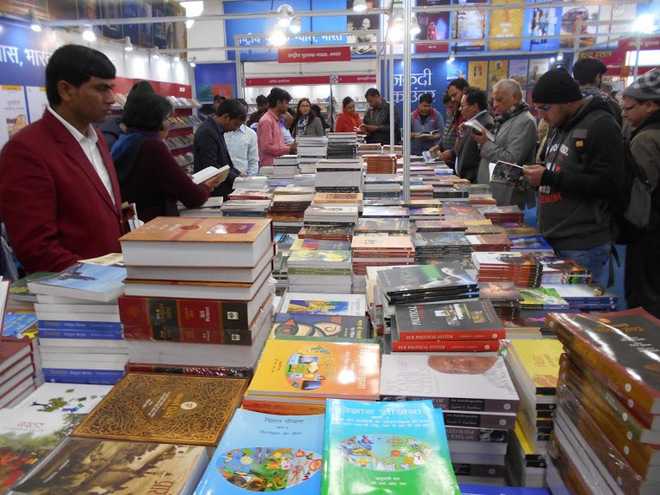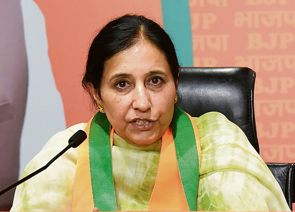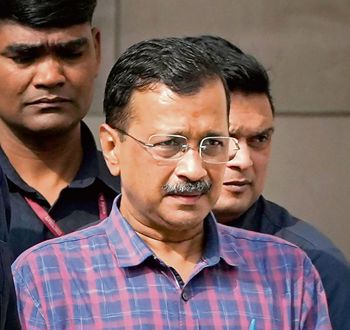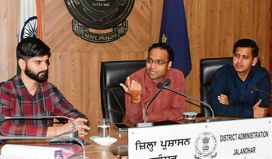
ALL EYES: Visitors throng the stalls and some of the books on display
Kuldip Dhiman
The week-long New Delhi World Book Fair 2018 is drawing huge crowds in spite of the internet and e-books. A welcome trend in the book fairs of such kind is the revival of interest in vernacular literature. The popularity of vernacular literature has increased so much that two halls have been reserved especially for them at the current New Delhi World Book Fair.
“It is true that in the past there was a decline in vernacular readers, but from the past few years, I have noticed a revival of interest in our own country and culture, especially among the young,” says Mahohar Batham, Chief Manager (Operations), Bharatiya Jnanpith. Himself an author of 38 books, Batham says, “In the seventies and eighties, there was an alarming feeling that Indian languages are going to be extinct soon. Now, I notice that though English has its importance, other languages are becoming increasingly popular.”
The claim is evident from the huge number of visitors flocking the Bharatiya Jnanpith stall and other stalls selling regional language books.
“I have worked all over India in various regions. In the past several regions of the country such as the Northeast were not represented at book fairs, but now you will see that Northeastern languages, culture, literature is very getting very popular. The same is true of other languages. Translations from the regional languages to other languages, as well as English, have made the regional authors popular in other states.”
Positive trends
Agreeing with the positive trend in the vernacular readers, Vivek Charan of the National Book Trust says, “In the past decade or so, there has been a consistent increase in the number of Hindi, Tamil, Bengali, Telugu, Urdu and readers of several other languages. There is a whole crop of new writers in almost all regional languages. To date, NBT has published 7,600 titles in various languages. Apart from this, we have published a great number of books for children.” You can see the large crowds in our stall here. We have introduced the authors’ corner where writers interact with their readers.”
A unique stall at the book fair is that of the Rampur Raza Library. Established by several Nawabs of the Rampur State, it has very rare collection of manuscripts, historical documents, specimens of Islamic calligraphy, miniature paintings, astronomical instruments and rare illustrated works in Arabic and Persian languages, besides 60,000 printed books in Urdu, Hindi and Persian.
“Our focus is on research, not general books. Over the years, we have encouraged several Urdu as well as Hindi scholars,” says Isba Khan. “Because of serious research work done at the Rampur Raza Library, people have come to know of the rich literary treasure of India. We have some very rare and unusual translations. For example, we have a Ramayana that was originally in Persian during the time of Dara Shikoh. We have had it translated into Hindi.”
Price matters
The small press has always been active in promoting literature and language. Vibhor Aggarwal of Sahitya Bhandar, Allahabad, says, “Hindi readers are increasing and because of this sale of Hindi books is increasing by the day.” The secret of Sahitya Bhandar’s success is to keep the price very low. “We have printed a series of big authors for only Rs 50; this is very tempting for the book lover. By keeping the price low, we manage to sell more.”
How do they manage to sell at such a low price? “We sell direct from our showroom or at book fairs. We do not offer discounts to booksellers.”
Punjabi low
While more and more books are being published in Bengali, Hindi, Oriya, Assamese, Gujarati, Kannada, Telugu, Tamil, Malayalam, and Marathi, the publishing scene in Punjabi is not very vibrant.
Gurcharan Singh, who mans the stall of RC Publishers at the book fair, says, “The footfall is fairly okay, but not as good as it ought to be. The serious reader, no doubt, comes to us, but the scene is not as vibrant as in English language stalls.”
What is the reason for the lack of interest in Punjabi books? “Our readers are mainly Punjabis, and Punjabis have the money to buy a ‘bottle’ but do not have the money to buy a book. Government is doing nothing to promote reading habits among Punjabis. Look at Christian organisations, how they distribute books free of cost and make their language popular.”
Talking about the sorry state of Punjabi publishing, Simrat Kaur, a research scholar, says, “Punjabis think buying books is a waste of money, and reading them is a waste of time. We should not wait for government patronage, but each parent can start cultivating reading interest among children right from the beginning.”
(On till today)



























